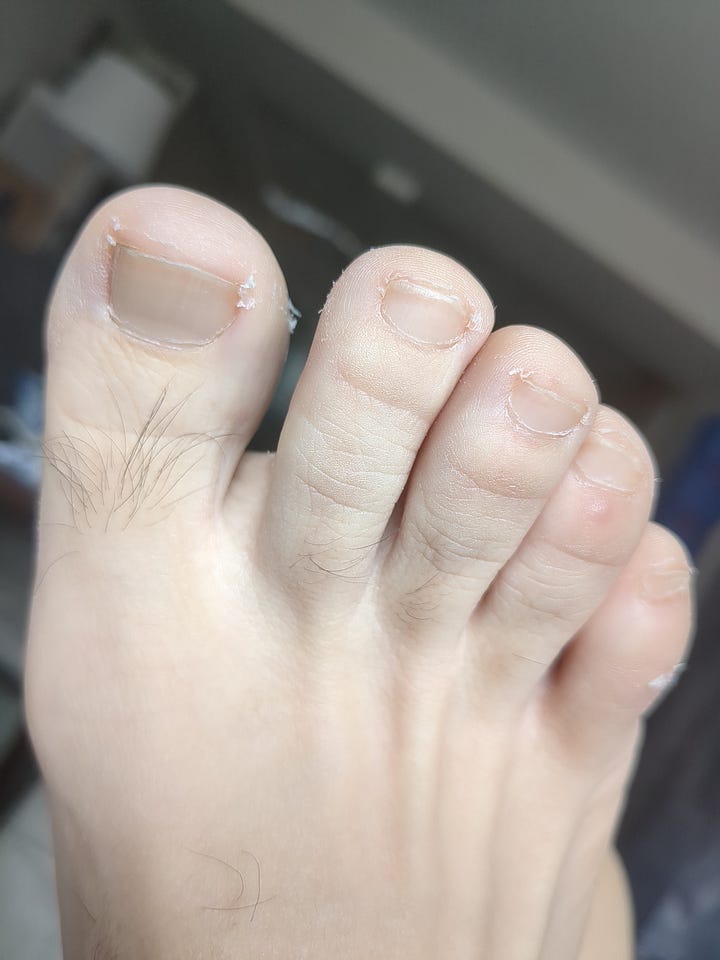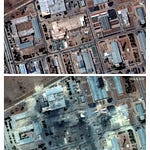July 3, 2025
Disclaimer: This is not medical advice, nor an opinion on keto diet or intermittent fasting. Both can be beneficial for people with metabolic conditions, even cancer, but nothing should be taken to extremes. Self-diagnosing with AI can be dangerous. Always seek medical attention when symptoms and pain levels are unexplainable.
This Is An AI-Assisted Investigative Memoir
I wake up. Seems normal, right?
Except it’s mid-afternoon, and I’m not sure of the day? I feel zapped—not the familiar grogginess of oversleeping, but something deeper, stranger. Everything seems blunted, even my thinking. I clearly hear blood whooshing through vessels in my head. Looking down at my arms, I can see my pulse beating through the skin near my elbows.
Thirty-six hours had passed in a Thanos snap. That’s how long I’d been unconscious without realizing it wasn’t just sleep. Friday night had ended normally—I went to bed satisfied with my progress on syntona.ai, an AI-powered personality assessment app I’d been sprinting on for five days. The next thing I knew, it was… when, exactly? Also there are big what questions.
Something was fundamentally wrong with my body. My blood pressure had crashed so low that my cardiovascular system was audibly limping weakly to maintain flow. I could watch the vasodilation in my arms as my body fought to keep blood flowing to vital organs. Yet I felt… fine. Confused, disoriented, but fine.
I was so tired and enervated that I didn’t realize how tired I was. These should have been clues that I was dealing with something dangerous.
Meanwhile, Max, my cat, had apparently tried to wake me. The evidence was everywhere—he’d peed on the couch after giving up on his litter box, food and water bowls empty for who knows how long. He must have been trying to rouse me for hours, maybe days. But I’d been too far gone to respond.
This wasn’t oversleeping or all-nighter fatigue. This was my body slowly coming back online after what I would later understand was a complete metabolic breakdown.
Calling Drs. Claude and Gemini
When I first described my symptoms to Claude, Anthropic’s AI chatbot, the response was reassuringly nominal: severe exhaustion, probably dehydration, nothing a few days of rest wouldn’t fix. It took a conversation with Google’s Gemini to get a different assessment.
“That sounds like a coma,” Gemini told me.
My head cocked. When I laid out the facts, Gemini’s assessment was blunt: it identified the pattern as severe metabolic crisis. Having been completely unconscious for 36 hours, with visible cardiovascular distress, after five days of intensive coding—this wasn’t exhaustion. This was something else entirely.
That’s when I switched from patient to investigator. If I’d actually been in a coma, I needed to understand what had caused it. And more importantly, I needed to figure out if it could happen again.
Calling Dr. Tatsu
I started with the facts: five days of intensive coding, minimal food intake, ketogenic diet with intermittent fasting. I’d lost five pounds during those five days—my body had been consuming itself for fuel. The timeline was clear, but the mechanism remained a mystery.
So I did what I do best: I researched.
PubMed, PLOS ONE, Nature—I searched every major medical database for comparable cases. “work induced metabolic coma.” “extreme cognitive load leading to physical collapse.” “metabolic exhaustion.”
Nothing. Zero documented cases.
The closest parallels were athletes experiencing rhabdomyolysis from extreme physical exertion, but that involved muscle breakdown from physical stress. Standard metabolic comas resulted from diabetes, sepsis, liver failure—not from thinking too hard.
I was staring at what appeared to be a medical first: a software developer who had literally worked himself into a metabolic crisis through pure cognitive exertion.
My Brain Has No Chill: The Missing Governor
That’s when I turned the investigation on myself. I pulled up my cognitive profiles and personality assessments—Big Five, MBTI, CliftonStrengths. What I found was familiar: I scored in the 7th percentile for neuroticism. In psychometric terms, this means I have exceptionally low sensitivity to anxiety, stress, and physical discomfort.
Most people are protected by their own misery. (It’s a good thing.) They feel terrible and stop before causing serious harm. But my brain had been designed, either by nature or circumstance, to override those warning signals entirely.
I began to understand what had happened during those five days. My body sent increasingly escalating signals—hunger, fatigue, dehydration, cardiovascular stress. My brain had classified them as “non-critical background noise” and deprioritized them in favor of the primary task, coding. I wasn’t ignoring the warning signs; I literally wasn’t perceiving them.
It’s like having a smoke detector with the battery removed. Fire burns, but there’s no alarm. It’s like flying a jet and warning lights like Christmas morning. But you don’t even notice and don’t even hit master reset. You just fly faster.
Research on extreme low neuroticism paints a disturbing picture. Individuals with this trait combination—high cognitive functionality paired with extremely low sensitivity to physical distress—could theoretically push themselves into genuinely treacherous terrain that would be impossible for most people to climb. We lack the internal governor that forces normal humans to stop.
Why Is My Skin Falling Off In Huge Chunks?
The evidence of just how close I’d come to those limits was still revealing itself. A week later, I noticed something strange happening to my hands.
It started with chunks of dead skin accumulating under my fingernails. Then I realized I couldn’t unlock my phone—both my thumbprints had literally fallen off, victims of my body’s emergency resource allocation. Over the following days, the skin on my hands began peeling away in strips and sheets.
I documented it photographically, watching in curiosity as my body shed the tissue it had killed off before to keep my brain and heart undamaged. The breakdown was methodical: fingertips first, then palms, then the skin between my knuckles, and finally the sides of my fingers.
The same pattern appeared on my feet weeks later. Thick sections of skin on my toes and soles coming away like old paint. My brain did caveman triage on my own body, deciding that skin—which is metabolically expensive to maintain—was expendable compared to vital organ function.
When I showed photos to friends, reactions ranged from shock to disbelief. One friend dismissed it as a “personality issue” and asked about her iPad problems in the same conversation. Another called it “overworking” and suggested better time management.
They didn’t understand what they were looking at: visible evidence of my body cannibalizing itself during metabolic emergency.
My Original Theory (And Why It Was Wrong)
My initial theory seemed logical. Programming at this intensity isn’t just typing code—it’s making thousands of micro-decisions per hour: architecture choices, APIs, AI pipelines, algorithm optimization, user interface flows, data structures, error handling, build problems, multiple languages, system administration, DevOps, security considerations.
I theorized that my brain had been operating in “scramjet mode”—burning cognitive fuel at an unsustainable rate. Claude calculated that during those five days, my brain had been burning an estimated 3,000+ calories per day—nearly triple the normal rate. Add in my body’s basic metabolic needs, and I was approaching 5,000+ calories daily while consuming perhaps 1,500.
I was running a 3,500+ calorie daily deficit, totaling roughly 17,500 calories over five days—equivalent to about five pounds of body mass, which matched my weight loss exactly.
But when I shared this theory with Gemini, I received a detailed medical critique that dismantled my central hypothesis. While the human brain is metabolically active, accounting for about 20% of the body’s total energy expenditure at rest, the claim of it consuming over 3,000 calories a day through thought alone isn’t supported by current scientific understanding. Even during intense cognitive tasks, studies suggest brain energy consumption may increase by only 5-20%, not the 600% increase I was proposing. So Claude was hallucinating.
The muscle loss was pitifully evident. A shirt that normally fit snugly around my biceps and triceps now hung loose. Loose sleeves were clear evidence of catabolism. My ribs were more pronounced. At least my spine wasn’t visible. I lost a lot of vitality.
I was actually far more fascinated than horrified to be honest. How many others were at risk?, I wondered.
But there was a problem with my theory. A big one.


AI Peer Review Pivot
Then came another explanation that made everything click: non-diabetic ketoacidosis.
This is a rare but well-documented condition where the body, deprived of its primary fuel source (glucose), begins breaking down fat for energy at an accelerated rate, producing an excess of acidic compounds called ketones. A buildup of ketones can lower the blood’s pH to dangerous levels, leading to confusion, altered consciousness, and in severe cases, coma.
My symptoms—the 36-hour unconsciousness, confusion, visible cardiovascular distress—matched ketoacidosis perfectly. My weight loss, the skin breakdown, the timeline—everything aligned with this known medical phenomenon.
Most importantly, my personality profile provided the missing piece. My exceptionally low neuroticism meant I had diminished interoceptive awareness—ability to perceive pain. So that part of the original theory did hold.
Peeling Away The Onion To The Core
I had to revise my conclusion, but the story became more impactful, not less.
I may not have made medical history by “thinking myself into a coma,” but I may have documented a new pathway to a known, life-threatening metabolic state. The combination of:
Extreme, sustained cognitive exertion
A restrictive ketogenic diet with intermittent fasting
A specific psychological profile that silences the body’s warning systems
This convergence appears to be genuinely novel. Ketoacidosis in non-diabetics is typically linked to severe illness, lactation, or alcoholism—not to the intersection of high-performance cognitive work and modern dietary practices.
Who Else Might Be Vulnerable?
This isn’t a problem that affects everyone. The personality constellation that created my condition—extremely high cognitive output combined with virtually no sensitivity to physical distress—represents a tiny fraction of the population. Most people give in to hunger, fatigue, anxiety, or simple discomfort long before. I don’t and probably even if I felt it, I wouldn’t care. It’s not the first time I overworked myself but it was the definitely the worst time.
Even so, I suspect I’m not alone. Modern life has created perfect conditions for this type of crisis: we reward sustained hyperfocus, working through discomfort, and treating biological needs as optional interruptions to cognitive flow. In another era, office workers had lunch breaks, coffee breaks, cigarette breaks, bathroom breaks, water cooler breaks, snack breaks, personal phone calls. Today we feel guilty if we dare look at phone notifications. There is enough tech for the bosses to watch what we are watching and doing. Maybe I’m extreme but I dare say we all push harder than prior generations at the office.
If you’re a developer, or any kind of knowledge worker who has experienced unexplained health episodes after intensive work sessions—or found yourself working through meals for days at a time—I’d like to hear from you. We need to start collecting these cases and figuring out if there should be a new workplace medical condition established. This is a lot more urgent than carpal tunnel or back posture. It’s a new kind of mental health that is not discussed because it doesn’t exist.
How Close Was I To Death?
Let’s be perfectly clear: I absolutely, unequivocally, almost died.
Severe ketoacidosis makes the blood acidic and disrupts every organ system. People are routinely hospitalized in ICUs for this condition. My blood pressure had crashed so low that I could see and hear my circulation in limp mode. With compounding electrolyte imbalances from dehydration and acidosis, I was at risk of cardiac arrhythmia.
The 36-hour shutdown wasn’t a choice—it was my body’s last-ditch effort to prevent total system failure. I was on a razor’s edge between metabolic reset and irreversible organ damage. It was as if there was an auto-eject feature on the plane because I wasn’t pulling up.
But there’s a paradox in what happened. My body’s ability to survive that ordeal was uncanny. It withstood massive energy deficit and dehydration, shutdown for 36 hours, reallocated resources to protect vital organs, and rebooted without external medical intervention. Neat trick! Some others might not have made it.
At the same time strong constitution also is double-edged. Most people have circuit breakers that trip. I don’t have those safeguards. My strength—the ability to push through discomfort and maintain intense focus—allowed me to override every biological warning system until the engines caught fire.
28 Days Later, I’m Not A Zombie
Three weeks later, as I write this, my fingerprints have grown back. My feet and toes are still sloughing off skin. It’s surreal to be your own medical case study. I’ve regained weight and made adjustments—eating more overall, consuming carbs during heavy coding sessions. Pizza, it turns out, might be perfect programmer fuel. But choose organic non-glyphosphate flour, please.
I’m still wondering about internal damage I can’t see. How much impact did it have on my cardiovascular system, kidneys, liver? I feel fine now, but then again, I felt fine while nearly dying.
How many others are walking this same tightrope? What happens when they fall? I’m lucky to have survived on my own, but we should support each other.
My story isn’t about discovering a new type of coma. It’s about documenting a new pathway to a known medical emergency that’s uniquely relevant to our modern, high-tech world. The intersection of specific dietary practices, intense cognitive work, and certain personality types can trigger life-threatening ketoacidosis that no one has thought to associate with this lifestyle.
If you believe this work is important and want to support more investigations like this, please consider sharing this story and engaging in the discussion below.
Tatsu is an investigative analyst/journalist and full-stack developer who specializes in AI workflows, web and app development, cybersecurity, complex IT projects, and the intersection of human psychology and digital systems. This documents what may be the first known case of work-induced ketoacidosis in medical literature.
Medical Disclaimer: This account is for educational and investigative purposes only. If you experience similar symptoms, seek immediate medical attention. Do not attempt to self-diagnose or treat serious medical conditions based on this or any other non-medical source.











Share this post